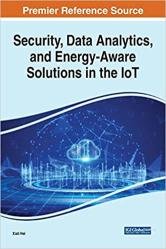Security, Data Analytics, and Energy-Aware Solutions in the IoT
- Добавил: literator
- Дата: 30-01-2023, 19:29
- Комментариев: 0
 Название: Security, Data Analytics, and Energy-Aware Solutions in the IoT
Название: Security, Data Analytics, and Energy-Aware Solutions in the IoTАвтор: Xiali Hei
Издательство: IGI Global
Год: 2022
Страниц: 240
Язык: английский
Формат: pdf (true), epub (true)
Размер: 33.4 MB
Internet of Things networks have shown promising outcomes in the provisioning of potentially critical services such as safety applications, healthcare, and manufacturing. However, there are many challenges related to the security, data analysis, and limited resources of the performed operations that require further investigation. Additional research is necessary to address the concerns and doubts of researchers and industry professionals in the Internet of Things. Security, Data Analytics, and Energy-Aware Solutions in the IoT reports novel methodologies, theories, technologies, and solutions for security and data analytics techniques and energy-aware solutions for the Internet of Things. Covering a wide range of topics such as laser attacks and personal data, it is ideal for academicians, industry professionals, researchers, instructors, and students.
In this book, the authors discussed the basics, as well as complex security flaws present in different technologies. Chapter 1 discusses about the challenges involved in designing efficient and intelligent Internet of Things Search Engine (IoTSE). Chapter 2 discusses the IoT from a legal perspective. In Chapter 3, the authors analyzed various cell phone biometric sensors and the security risks of those sensors. In this chapter, the authors discussed the fingerprint and the facial recognition process, the hardware, and the algorithms needed for these recognition systems. Later the authors discussed the types of attacks that can be performed to spoof these recognition systems and the countermeasures. In Chapter 4, the attacks on voice assistant systems are discussed. The authors of this chapter first provided the idea of different types of attacks based on hardware non-linearity, obfuscated, and adversarial attacks and discussed the solutions.
In Chapter 5, a brief survey of automotive cyber-physical systems security has been provided. The authors of this chapter briefly discussed the cyber-physical systems and then discussed them in the context of automobiles. Then they discussed the security threats in different layers of automotive cyber-physical systems, such as threats in sensing and communication layers. Chapter 6 discuss the method to spoof handwritten signatures in electronic check using Conditional Generative Adversarial Network (CGAN). Chapter 7 reviewed handwritten signature spoofing with generative adversarial networks. In Chapter 8, a deep learning approach to protect voice-controlled devices from laser attacks is presented. Chapters 9 and 10 discuss the security of teleoperated surgical robots and attacks on brain-computer interfacing devices. These chapters will give a brief idea about the attacks that can be mounted on these technologies and the preventative measures to the attacks presented in the book. Chapter 11 discusses Implantable Medical Device (IMD) security. This chapter first presented the types of attacks that can be mounted on IMDs, and then presented pacemakers as an example for the case study.
The first chapter discusses the Internet of Things Search Engines (IoTSE) as a platform to support efficient data analytics. Internet of Things (IoT) has been emerging as the next big thing in the world. It is envisioned that billions of physical things or objects will be outfitted with different kinds of sensors and actuators and connected to the Internet via heterogeneous access networks enabled by technologies such as embedded sensing and actuating, radio frequency identification (RFID), wireless sensor networks, real-time and semantic web services, etc. IoT is actually cyber-physical systems or a network of networks. With the huge number of things/objects and sensors/actuators connected to the Internet, a massive and, in some cases, the real-time data flow will be automatically generated by connected things and sensors. It is essential to collect correct raw data in an efficient way, but more important is to analyze and mine the raw data to abstract more valuable information such as correlations among things and services to provide a web of things or Internet of services. This is where IoTSE comes into play. IoTSE is a platform to support efficient data analytics. There are a number of challenges in designing efficient and intelligent IoTSE. The first chapter focuses on the efficiency issue of IoTSE and designs the Named Data Networking (NDN)-based approach for IoTSE. At first, a simple simulation environment is designed to compare the IP-based network’s performance against Named Data Networking (NDN). Then four scenarios tailored to study the approach’s resilience are created to address network issues and scalability with the growing number of queries in IoTSE. These four scenarios are implemented, and extensive performance evaluation is carried out to determine the approach’s efficacy concerning network resilience and scalability.
Скачать Security, Data Analytics, and Energy-Aware Solutions in the IoT
[related-news] [/related-news]
Внимание
Уважаемый посетитель, Вы зашли на сайт как незарегистрированный пользователь.
Мы рекомендуем Вам зарегистрироваться либо войти на сайт под своим именем.
Уважаемый посетитель, Вы зашли на сайт как незарегистрированный пользователь.
Мы рекомендуем Вам зарегистрироваться либо войти на сайт под своим именем.
